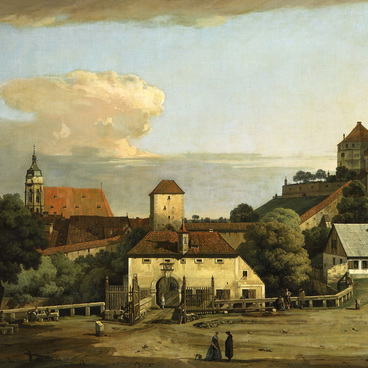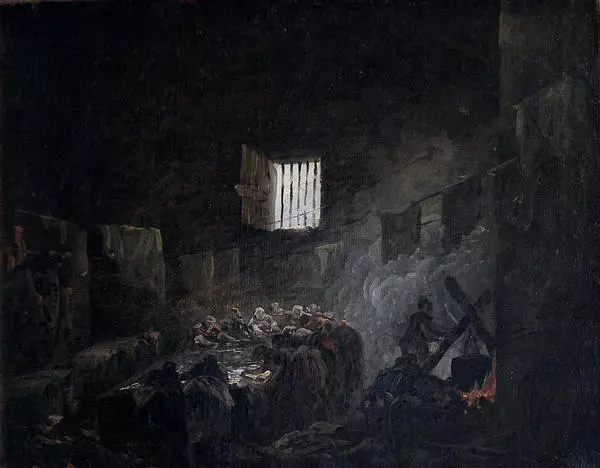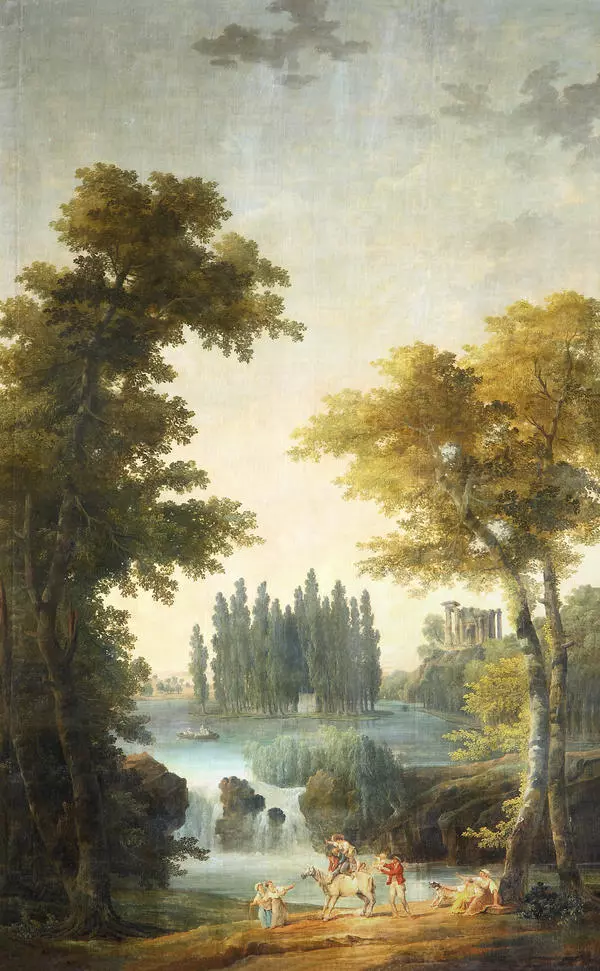The canvas ‘At the Fountain’ is a work by the French painter and sketcher Hubert Robert. It depicts one of the quiet corners in the center of Rome. In ‘Eternal City, ’ Robert lived for thirteen years (1754 — 1767), and it was here where he formed as an artist. He took his interest in ruins as symbols of the destroying force of nature and aspiration to idealization of a landscape after Roman masters of an architectural landscape — Panini and Piranezi. In Rome, the artist wrote the painting ‘At the Fountain’.
There’s an antique statue of the goddess Minerva in the niche of the wall-mounted fountain depicted in the center of the painting. Pouring out water falls into a marble sarcophagus. The existence of the ancient goddess of wisdom and war, the patron of medicine, sciences, arts and crafts, was remembered only by poets, artists and scientists in the 18th century. And therefore, only they understood the meaning and value of this fountain.
With his specific soft humor, Robert shows how the water of the fountain, once considered sacred, is used for laundry by two women. The third woman, having placed a large clay vessel with water on the head, prepared to leave, but met with a friend and stopped to chat. There was a little bargaining nearby. We can see a real still life with asparagus, pumpkin and radish on the steps of the fountain. It is likely that vegetables were brought from the village by a peasant, whose round-backed figure on the horse the artist depicted on the right, deep in wood scenes. On the right in depth behind trees can be seen the main shrine of the Catholic world ― St. Peter’s Cathedral with columns and dome.
Although architectural features dominate in the painting, the impression of everyday chores of ordinary people is stronger. With his typical joyful perception of life, the artist captured a summer sunny morning when the sky shines with pure blue and the game of light and shadow is so contrasting and expressive. There is also no trace of the painful mood that usually occurs in the viewer while contemplating abandoned decaying monuments.
For a long time, the author of the painting ‘At the Fountain’ was considered Italian artist Domenico Roberti. The reason for such attribution was the misread Latinized signature of the artist on the canvas: ‘ROBERT.’ However, in the late 1950s, the staff of the Levinson-Lessing Hermitage and Linnik who visited the Alupkin Museum recognized this painting as a work by Huber Robert.
There’s an antique statue of the goddess Minerva in the niche of the wall-mounted fountain depicted in the center of the painting. Pouring out water falls into a marble sarcophagus. The existence of the ancient goddess of wisdom and war, the patron of medicine, sciences, arts and crafts, was remembered only by poets, artists and scientists in the 18th century. And therefore, only they understood the meaning and value of this fountain.
With his specific soft humor, Robert shows how the water of the fountain, once considered sacred, is used for laundry by two women. The third woman, having placed a large clay vessel with water on the head, prepared to leave, but met with a friend and stopped to chat. There was a little bargaining nearby. We can see a real still life with asparagus, pumpkin and radish on the steps of the fountain. It is likely that vegetables were brought from the village by a peasant, whose round-backed figure on the horse the artist depicted on the right, deep in wood scenes. On the right in depth behind trees can be seen the main shrine of the Catholic world ― St. Peter’s Cathedral with columns and dome.
Although architectural features dominate in the painting, the impression of everyday chores of ordinary people is stronger. With his typical joyful perception of life, the artist captured a summer sunny morning when the sky shines with pure blue and the game of light and shadow is so contrasting and expressive. There is also no trace of the painful mood that usually occurs in the viewer while contemplating abandoned decaying monuments.
For a long time, the author of the painting ‘At the Fountain’ was considered Italian artist Domenico Roberti. The reason for such attribution was the misread Latinized signature of the artist on the canvas: ‘ROBERT.’ However, in the late 1950s, the staff of the Levinson-Lessing Hermitage and Linnik who visited the Alupkin Museum recognized this painting as a work by Huber Robert.






